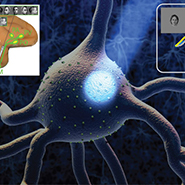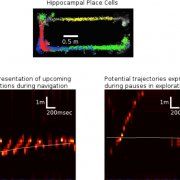The hippocampus and associated brain structures are known to simultaneously represent a subject’s ongoing location, directional heading and movement-related correlates during active locomotion. Of these areas, the hippocampus appears to play a central role in navigation because, at fine temporal scales, its spatial representations also predict immediate upcoming locations much like a neuronal GPS. Besides tracking the subject’s current position, recent evidence demonstrates that during pauses in navigation the hippocampus encodes sequences of locations that correspond to trajectories that the subject either followed to arrive to its current position or will follow to complete its path to a goal location. Thus, the hippocampus is also able to provide the required representations to support planning which is an essential component of intelligence. In this project we study the hippocampus along with brain structures implicated in navigation to identify whether and how they interact to solve one of the Center’s challenges of “Where did I come from?” and “Where am I going to?”. We focus our attention on the anterior dorsal thalamus, which acts as a neuronal compass by encoding the subject’s current heading direction, and the retrosplenial cortex, which receives and processes egocentric and allocentric spatial information during navigation. We employ large-scale, multi-site recording techniques to simultaneously sample the activity of several brain structures during the execution of different behavioral tasks. We exploit different decoding and computational strategies to interpret ensemble spiking patterns to help us uncover how spatial information is represented and potentially communicated along these structures to enable spatial planning.
Neural Circuits for Intelligence
 Abstract thinking and complex problem solving constitute paradigmatic examples of computation emerging from interconnected neuronal circuits. The biological hardware represents the output of millions of years of evolution leading to neuronal circuits that provide fast, efficient, and fault-tolerant solutions to complex problems. Progress toward a quantitative understanding of emergent intelligent computations in cortical circuits faces several empirical challenges (e.g., simultaneous recording and analysis of large ensembles of neurons and their interactions), and theoretical challenges (e.g., mathematical synthesis and modeling of the neuronal ensemble activity). Our team of theoreticians and neurophysiologists is focused on systematic, novel, and integrative approaches to deciphering the neuronal circuits underlying intelligence. Understanding neuronal circuits that implement solutions to complex challenges is an essential part of scientific reductionism, leading to insights useful for developing intelligent machines.
Abstract thinking and complex problem solving constitute paradigmatic examples of computation emerging from interconnected neuronal circuits. The biological hardware represents the output of millions of years of evolution leading to neuronal circuits that provide fast, efficient, and fault-tolerant solutions to complex problems. Progress toward a quantitative understanding of emergent intelligent computations in cortical circuits faces several empirical challenges (e.g., simultaneous recording and analysis of large ensembles of neurons and their interactions), and theoretical challenges (e.g., mathematical synthesis and modeling of the neuronal ensemble activity). Our team of theoreticians and neurophysiologists is focused on systematic, novel, and integrative approaches to deciphering the neuronal circuits underlying intelligence. Understanding neuronal circuits that implement solutions to complex challenges is an essential part of scientific reductionism, leading to insights useful for developing intelligent machines.

